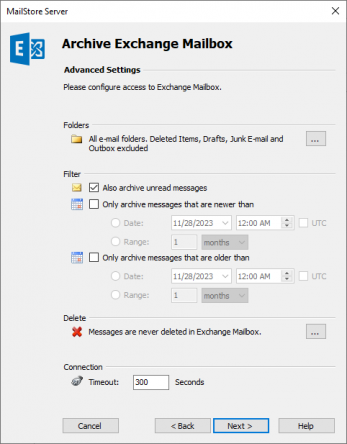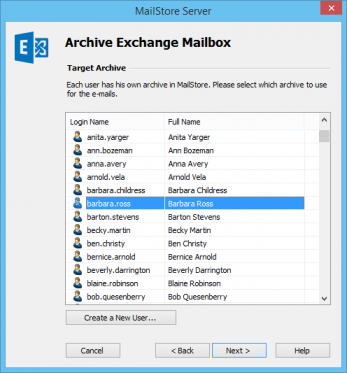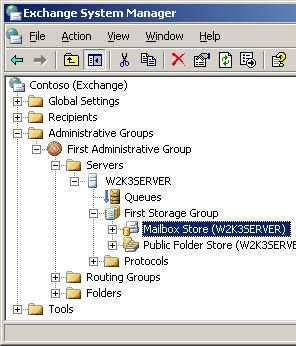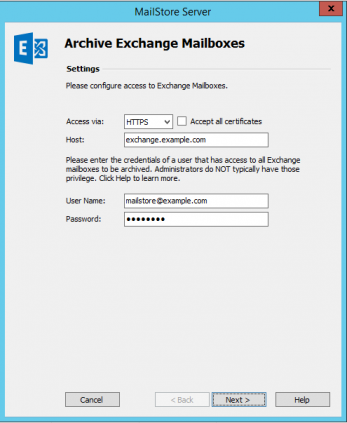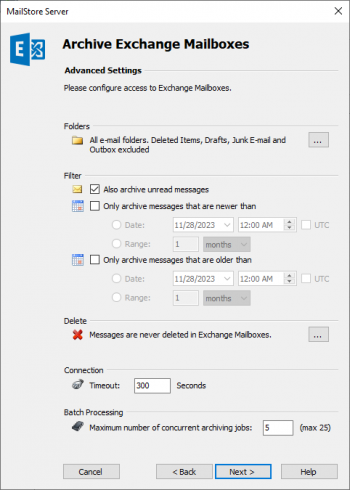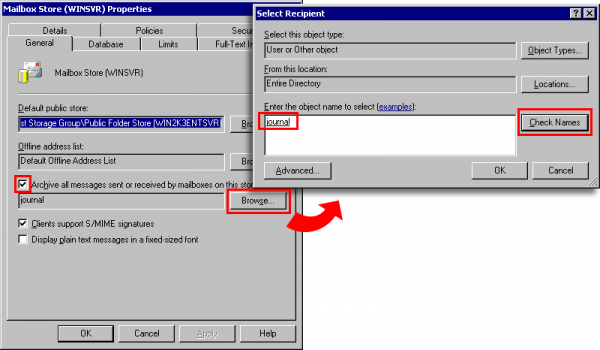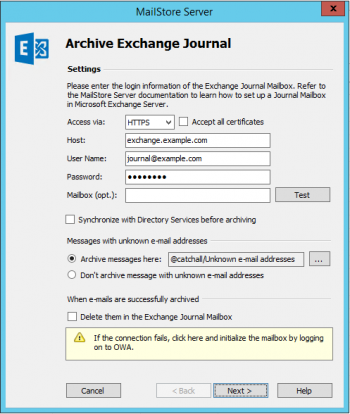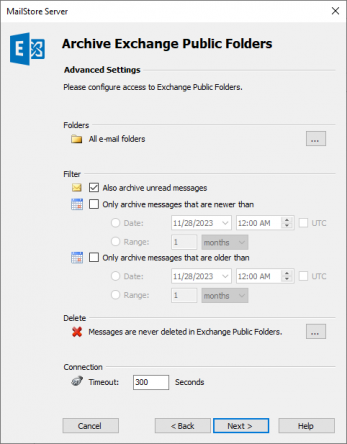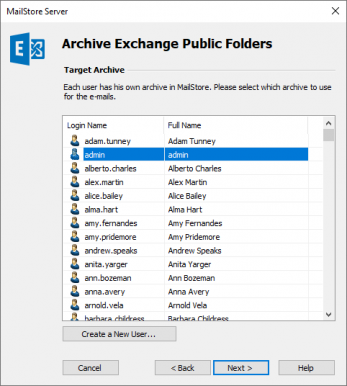Difference between revisions of "Archiving Emails from Microsoft Exchange 2003"
| [unchecked revision] | [checked revision] |
Ltalaschus (talk | contribs) |
|||
| (24 intermediate revisions by 3 users not shown) | |||
| Line 1: | Line 1: | ||
| − | + | <p class="msnote mswarning">Support for Microsoft Exchange Server 2003 has been permanently removed from MailStore Server 23.4 and all subsequent versions.</p> | |
| − | + | {{Implementation_Guide_Preamble|Microsoft Exchange 2003 Server}} | |
| − | = | + | == Synchronizing Users == |
| + | As Microsoft Exchange requires the existence of an Active Directory, it is recommended to set up a synchronization as described in chapter [[Active Directory Integration]] of the MailStore Server manual. | ||
| − | + | == Archiving Individual Mailboxes == | |
| − | + | {{Archiving Exchange Single Mailbox}} | |
| + | <p class="msnote"> '''Important notice for Microsoft Exchange 2003:''' A newly created mailbox, that has never been accessed with Outlook Web Access, may be in a state that MailStore Server is unable to archive email from. In that case it is required that you (or the mailbox owner) logs into the mailbox at least one time using Outlook Web Access in order to correctly initialize the WebDAV interface for that mailbox.</p> | ||
| + | |||
| + | == Archiving Multiple Mailboxes Centrally == | ||
MailStore can archive some or all Exchange mailboxes in one step either manually or according to a schedule. All necessary preparations, such as adding MailStore users, can be made automatically. | MailStore can archive some or all Exchange mailboxes in one step either manually or according to a schedule. All necessary preparations, such as adding MailStore users, can be made automatically. | ||
| Line 15: | Line 19: | ||
<p class="msnote">'''Please note''': To be able to archive multiple mailboxes of an Exchange 2003 server in one step, Service Pack 2 must be installed.</p> | <p class="msnote">'''Please note''': To be able to archive multiple mailboxes of an Exchange 2003 server in one step, Service Pack 2 must be installed.</p> | ||
| − | == Step 1: Preparation: Setting up a central user for accessing mailboxes == | + | === Step 1: Preparation: Setting up a central user for accessing mailboxes === |
* Add a new user with full access to all mailboxes. This user does not need to have an Exchange mailbox. | * Add a new user with full access to all mailboxes. This user does not need to have an Exchange mailbox. | ||
* Start ''Microsoft Exchange System Manager''. It is generally located in the Start menu under ''Microsoft Exchange'' | ''System-Manager''. | * Start ''Microsoft Exchange System Manager''. It is generally located in the Start menu under ''Microsoft Exchange'' | ''System-Manager''. | ||
| Line 30: | Line 34: | ||
|} | |} | ||
| − | == Step 2: | + | === Step 2: Setting Up the Archiving Process === |
| + | {{Archiving Exchange Multiple Mailboxes}} | ||
| − | + | <p class="msnote"> '''Important notice for Microsoft Exchange 2003:''' A newly created mailbox, that has never been accessed with Outlook Web Access, may be in a state that MailStore Server is unable to archive email from. In that case it is required that you (or the mailbox owner) logs into the mailbox at least one time using Outlook Web Access in order to correctly initialize the WebDAV interface for that mailbox.</p> | |
| − | = Archiving Incoming and Outgoing Emails Directly = | + | == Archiving Incoming and Outgoing Emails Directly == |
With the support of the Exchange Server Journaling functionality, MailStore can archive the incoming and outgoing emails of all users automatically. This is the only way to ensure that all emails are archived in their entirety. | With the support of the Exchange Server Journaling functionality, MailStore can archive the incoming and outgoing emails of all users automatically. This is the only way to ensure that all emails are archived in their entirety. | ||
| − | + | === Basic Functionality === | |
| − | == Basic Functionality == | ||
Microsoft Exchange Server provides the option to take down all incoming, outgoing and internal email traffic. At the time of sending and receiving, a copy of the respective email is created and stored in a mailbox called Journal Mailbox. Additionally, the email is provided with a Journal report containing information about the actual senders and recipients. | Microsoft Exchange Server provides the option to take down all incoming, outgoing and internal email traffic. At the time of sending and receiving, a copy of the respective email is created and stored in a mailbox called Journal Mailbox. Additionally, the email is provided with a Journal report containing information about the actual senders and recipients. | ||
| Line 45: | Line 49: | ||
Before the archiving process can be set up in MailStore, Journaling has to be set up for the Exchange server. Please proceed as follows: | Before the archiving process can be set up in MailStore, Journaling has to be set up for the Exchange server. Please proceed as follows: | ||
| − | == Step 1: Activating Envelope Journaling == | + | === Step 1: Activating Envelope Journaling === |
| − | + | <p class="msnote">'''Please note''': Envelope Journaling is first available for Exchange 2000 Server with Post-Service Pack 3 and Exchange Server 2003 with Service Pack 1.</p> | |
| − | '''Please note''': Envelope Journaling is first available for Exchange 2000 Server with Post-Service Pack 3 and Exchange Server 2003 with Service Pack 1. | ||
Start MailStore Client and log on as MailStore administrator. Click on ''Management Shell'' and enter the following command: | Start MailStore Client and log on as MailStore administrator. Click on ''Management Shell'' and enter the following command: | ||
| Line 57: | Line 60: | ||
Successfully ENABLED Envelope Journaling for COMPANY | Successfully ENABLED Envelope Journaling for COMPANY | ||
| − | == Step 2: Creating a Mailbox for Journaling == | + | === Step 2: Creating a Mailbox for Journaling === |
| − | |||
Create a new user whose Exchange mailbox is to be used for Journaling. Through the console ''Active Directory Users and Computers'', add a new user with a meaningful name, e.g. ''journal''. | Create a new user whose Exchange mailbox is to be used for Journaling. Through the console ''Active Directory Users and Computers'', add a new user with a meaningful name, e.g. ''journal''. | ||
| − | == Step 3: Configuring the New Mailbox as Journal Mailbox == | + | === Step 3: Configuring the New Mailbox as Journal Mailbox === |
Open the Exchange System Manager. In the tree ''Server'', open the server name as well as the ''First Storage Group''. Right-click on ''Mailbox Store'' and select ''Properties''. | Open the Exchange System Manager. In the tree ''Server'', open the server name as well as the ''First Storage Group''. Right-click on ''Mailbox Store'' and select ''Properties''. | ||
| Line 78: | Line 80: | ||
Please keep in mind that in complex Microsoft Exchange environments it may take a few minutes until the Journaling settings become active. | Please keep in mind that in complex Microsoft Exchange environments it may take a few minutes until the Journaling settings become active. | ||
| − | '''Important notice''' | + | === Step 4: Setting up the Archiving Process === |
| + | {{Archiving Exchange Journal Mailbox}} | ||
| + | |||
| + | <p class="msnote"> '''Important notice for Microsoft Exchange 2003:''' A newly created mailbox, that has never been accessed with Outlook Web Access, may be in a state that MailStore Server is unable to archive email from. In that case it is required that you (or the mailbox owner) logs into the mailbox at least one time using Outlook Web Access in order to correctly initialize the WebDAV interface for that mailbox.</p> | ||
| + | |||
| + | == Public Folders == | ||
| + | MailStore Server can archive the emails from the public folders of Microsoft Exchange servers and make them available to some or all MailStore users. The archiving process can be executed manually or automatically according to a schedule. | ||
| + | |||
| + | === Preparation === | ||
| + | During archiving, emails are always assigned to individual users. Even when archiving a public folder, the user (or the user archive), for whom the emails are to be archived, has to be specified. | ||
| − | + | For this reason, first create a MailStore user for whom the public folder is to be archived. This user can be called publicfolder, for example. Next, all other users can be given access to the archive of the user publicfolder. This way, the archived content of the public folder is available to all MailStore users. | |
| − | + | If MailStore users are not to have access to the archived public folder, skip this step and simply archive the emails to the user archive of the administrator (admin). | |
| − | + | Information about how to create a new user in MailStore is available in the chapter [[Users,_Folders_and_Settings#User_Management|User Management]]. | |
| − | {{ | + | {{Archiving Exchange Public Folder}} |
| − | = | + | <p class="msnote"> '''Important notice for Microsoft Exchange 2003:''' A newly created mailbox, that has never been accessed with Outlook Web Access, may be in a state that MailStore Server is unable to archive email from. In that case it is required that you (or the mailbox owner) logs into the mailbox at least one time using Outlook Web Access in order to correctly initialize the WebDAV interface for that mailbox.</p> |
| − | |||
| + | == Troubleshooting == | ||
| + | The settings described above work in most cases. Yet, depending on the configuration of Microsoft Exchange Server, it is possible that a connection or registration fails even if all data has been entered correctly. If the suggestions in the corresponding error messages do not eliminate the problem, please try one or more of these alternative settings: | ||
| + | * Use ''HTTP'' instead of ''HTTPS''. | ||
| + | * Make sure that the field ''Mailbox (opt.)'' contains the user's email address if it is different from the user's Windows login name. | ||
| + | * Use ''IMAP'' (unencrypted), ''IMAP-TLS'' or ''IMAP-SSL'' (both encrypted) instead of ''HTTP(S)''. To use IMAP, it has to be activated in Exchange. | ||
| + | == Weblinks == | ||
| + | * {{MailStore Support}} | ||
[[de:E-Mail-Archivierung von Microsoft Exchange 2003]] | [[de:E-Mail-Archivierung von Microsoft Exchange 2003]] | ||
| + | [[en:Archiving Emails from Microsoft Exchange 2003]] | ||
Latest revision as of 13:05, 29 November 2023
Support for Microsoft Exchange Server 2003 has been permanently removed from MailStore Server 23.4 and all subsequent versions.
This implementation guide covers the specifics of archiving Microsoft Exchange 2003 Server mailboxes. It is assumed that you already have a MailStore Server installation or test installation and are familiar with the fundamentals of MailStore Server. Please refer to the Manual or the Quick Start Guide for more information.
MailStore Server offers several ways to archive emails from Microsoft Exchange 2003 Server mailboxes, which are described below. If you are not sure which archiving method best suits your company, please refer to the chapter Choosing the Right Archiving Strategy.
Synchronizing Users
As Microsoft Exchange requires the existence of an Active Directory, it is recommended to set up a synchronization as described in chapter Active Directory Integration of the MailStore Server manual.
Archiving Individual Mailboxes
For each mailbox, please proceed as follows:
- Unless the mailbox of the current user is to be archived into his or her own user archive, log on to MailStore Client as MailStore administrator. Only an administrator can archive emails for other users.
- Click on Archive Email.
- From the Email Servers list in the Create Profile area of the window, select Microsoft Exchange to create a new archiving profile.
- A wizard opens to assist in specifying the archiving settings.
- Select Single Mailbox.
- Under Access via, select the protocol to be used to access the Exchange server. Whenever possible, HTTPS should be used.
- Please note: If the certificate provided by the remote host cannot be verified (e.g. self-signed or signed by an unknown certificate authority), enable the option Accept all certificates to allow MailStore to establish a connection. As this option leads to an insecure configuration, warnings may appear in the summary and/or the dashboard.
- Under Host, enter the name of your Exchange server.
- Under User Name, enter the Windows login name of the user whose emails are to be archived (e.g. [email protected] or [email protected]).
- Please note: Alternatively, any user with the appropriate access permissions for the mailbox to be archived can be specified. In this case, it is imperative that this mailbox is specified under Mailbox (see below).
- Under Password, enter the user's password.
- The field Mailbox must be left blank if a user, whose Windows login name and password is being used, wants to archive his own mailbox. Otherwise, the primary email address of the user whose mailbox you want to archive has to be entered here.
- Click on Test to verify that MailStore can access the mailbox.
- Click on Next.
- If needed, adjust the settings for the List of Folders to be Archived, the filter and the Deletion Rules. By default, no emails will be deleted from the mailbox. The Timeout value only has to be adjusted in specific cases (e.g. with very slow servers).
Important notice: Did you specify IMAP as the protocol and have also defined a deletion rule? If so, folders containing no emails, such as Tasks, Calendar or Contacts have to be added to the list of excluded folders manually. This is the only way to avoid these folders being archived and deleted according to the deletion rule specified. Please read more in chapter Archiving Specific Folders.
- Click on Next to continue.
- If logged on to MailStore Server as MailStore administrator, the Target Archive can be specified. Select the archive of the user for whom the selected mailbox is to be archived. If the user does not exist yet, click on Create a New User.
- Click on Next.
- In the last step, a name for the archiving profile can be specified. After clicking Finish, the archiving profile will be listed under Saved Profiles and, if desired, can be run immediately or automatically.
Important notice for Microsoft Exchange 2003: A newly created mailbox, that has never been accessed with Outlook Web Access, may be in a state that MailStore Server is unable to archive email from. In that case it is required that you (or the mailbox owner) logs into the mailbox at least one time using Outlook Web Access in order to correctly initialize the WebDAV interface for that mailbox.
Archiving Multiple Mailboxes Centrally
MailStore can archive some or all Exchange mailboxes in one step either manually or according to a schedule. All necessary preparations, such as adding MailStore users, can be made automatically.
Before the archiving process can be set up in MailStore, a user with access to all mailboxes to be archived has to be added.
Please note: To be able to archive multiple mailboxes of an Exchange 2003 server in one step, Service Pack 2 must be installed.
Step 1: Preparation: Setting up a central user for accessing mailboxes
- Add a new user with full access to all mailboxes. This user does not need to have an Exchange mailbox.
- Start Microsoft Exchange System Manager. It is generally located in the Start menu under Microsoft Exchange | System-Manager.
- From the tree structure, select the appropriate Exchange server, the storage group (e.g. First Storage Group) and the mailbox store.
- Right-click onto the mailbox store and select Properties. Click on the Security tab.
- Click on Add to add the new MailStore user and grant the Send As and the Receive As Privileges.
Step 2: Setting Up the Archiving Process
Please proceed as follows:
- Log on to MailStore Client as MailStore administrator.
- Click on Archive Email.
- From the Email Servers list in the Create Profile area of the window, select Microsoft Exchange to create a new archiving profile.
- A wizard opens to assist in specifying the archiving settings.
- Select Multiple Mailboxes and click OK.
- Please note: To be able to archive multiple mailboxes, MailStore Server users along with their email addresses must exist in the MailStore Server user management. If this is not the case, MailStore Server will offer to set up and run the directory synchronization at this point. Once completed, the wizard will resume.
Alternatively, you can cancel the wizard and create users manually as described the in chapter User Management.
- Please note: To be able to archive multiple mailboxes, MailStore Server users along with their email addresses must exist in the MailStore Server user management. If this is not the case, MailStore Server will offer to set up and run the directory synchronization at this point. Once completed, the wizard will resume.
- Under Access via, select the protocol to be used to access the Exchange server. Whenever possible, HTTPS should be used.
- Please note: If the certificate provided by the remote host cannot be verified (e.g. self-signed or signed by an unknown certificate authority), enable the option Accept all certificates to allow MailStore to establish a connection. As this option leads to an insecure configuration, warnings may appear in the summary and/or the dashboard.
- Under Host, enter the name of your Exchange server.
- Under User Name and Password, enter the access data of the service account that has access to all mailboxes to be archived.
- Click on Next to continue.
- If needed, adjust the settings for the List of Folders to be Archived, the filter and the Deletion Rules. By default, no emails will be deleted from the mailbox. The Timeout value only has to be adjusted in specific cases (e.g. with very slow servers). Please keep in mind that these settings apply to all mailboxes to be archived, as specified in the next step.
- Select the users whose mailboxes are to be archived.
- The following options are available:
- All users with configured email address
Choose this option to archive the mailboxes of all users who are set up, along with their email addresses, in MailStore's user management. - All users except the following
Choose this option to exclude individual users (and thereby their Exchange mailboxes) from the archiving process, using the list of users below. - Only the following users
Choose this option to include individual users (and thereby their Exchange mailboxes) in the archiving process, using the list of users below. Only the mailboxes of those users explicitly specified will be archived. - Synchronize with Directory Services before archiving
If selected, the MailStore user list will be synchronized with the configured directory service before any archiving process is executed. This has the advantage that, for example, new employees will be created as MailStore users before archiving, so once the archiving process is executed, their Exchange mailbox is archived automatically as well. This option is especially recommended when the archiving process is to be executed automatically.
- Click on Next.
- In the last step, a name for the archiving profile can be specified. After clicking Finish, the archiving profile will be listed under Saved Profiles and can be run immediately or automatically, if desired.
Important notice for Microsoft Exchange 2003: A newly created mailbox, that has never been accessed with Outlook Web Access, may be in a state that MailStore Server is unable to archive email from. In that case it is required that you (or the mailbox owner) logs into the mailbox at least one time using Outlook Web Access in order to correctly initialize the WebDAV interface for that mailbox.
Archiving Incoming and Outgoing Emails Directly
With the support of the Exchange Server Journaling functionality, MailStore can archive the incoming and outgoing emails of all users automatically. This is the only way to ensure that all emails are archived in their entirety.
Basic Functionality
Microsoft Exchange Server provides the option to take down all incoming, outgoing and internal email traffic. At the time of sending and receiving, a copy of the respective email is created and stored in a mailbox called Journal Mailbox. Additionally, the email is provided with a Journal report containing information about the actual senders and recipients.
MailStore can be configured to archive this Journal mailbox at regular intervals. During this process, the emails from the Journal mailbox will be assigned to their respective MailStore users (i.e. their user archives) automatically. This means that each user is able to view only their own emails.
Before the archiving process can be set up in MailStore, Journaling has to be set up for the Exchange server. Please proceed as follows:
Step 1: Activating Envelope Journaling
Please note: Envelope Journaling is first available for Exchange 2000 Server with Post-Service Pack 3 and Exchange Server 2003 with Service Pack 1.
Start MailStore Client and log on as MailStore administrator. Click on Management Shell and enter the following command:
exejcfg
The Envelope Journaling feature in Microsoft Exchange is now activated. After pressing Enter, a success message should appear on the screen:
Successfully ENABLED Envelope Journaling for COMPANY
Step 2: Creating a Mailbox for Journaling
Create a new user whose Exchange mailbox is to be used for Journaling. Through the console Active Directory Users and Computers, add a new user with a meaningful name, e.g. journal.
Step 3: Configuring the New Mailbox as Journal Mailbox
Open the Exchange System Manager. In the tree Server, open the server name as well as the First Storage Group. Right-click on Mailbox Store and select Properties.
The dialog window Mailbox Store Properties opens:
- Mark the checkbox Archive all messages sent or received by mailboxes on this store.
- Click on Browse.
- Enter the name of the new user, e.g. journal.
- Click on Check Names. The name will be underlined and provided with additional information.
- Click on OK.
- In the Properties dialog window, click on OK again.
Please keep in mind that in complex Microsoft Exchange environments it may take a few minutes until the Journaling settings become active.
Step 4: Setting up the Archiving Process
Please proceed as follows:
- Log on to MailStore Client as MailStore administrator.
- Click on Archive Email.
- From the Email Servers list in the Create Profile area of the window, select Microsoft Exchange to create a new archiving profile.
- A wizard opens to assist in specifying the archiving settings.
- Select In- and Outbound Email Automatically.
- Please note: To be able to archive from a journal mailbox, MailStore Server users along with their email addresses must exist in the MailStore Server user management. If this is not the case, MailStore Server will offer to set up and run the directory synchronization at this point. Once completed, the wizard will resume.
Alternatively, you can cancel the wizard and create users manually as described the in chapter User Management.
- Please note: To be able to archive from a journal mailbox, MailStore Server users along with their email addresses must exist in the MailStore Server user management. If this is not the case, MailStore Server will offer to set up and run the directory synchronization at this point. Once completed, the wizard will resume.
- Under Access via, select the protocol to be used to access the Exchange server. Whenever possible, HTTPS should be used.
- Please note: If the certificate provided by the remote host cannot be verified (e.g. self-signed or signed by an unknown certificate authority), enable the option Accept all certificates to allow MailStore to establish a connection. As this option leads to an insecure configuration, warnings may appear in the summary and/or the dashboard.
- Under Host enter the name of the Exchange server.
- Under User Name and Password enter the credentials for the Exchange journal mailbox.
- If you want to access the journal mailbox through HTTP/HTTPS with credentials that are not those of the mailbox owner, you have to specify the primary email address of the journal mailbox in the field Mailbox (opt.).
- Click on Test to verify that MailStore can access the mailbox.
- Synchronize with Directory Services before archiving
If this option is enabled, the MailStore user list will be synchronized with configured directory service before the archiving process actually runs. This has the advantage that, for example, new employees will be created as MailStore users before archiving which enables MailStore to sort their emails into the correct archives. This option is recommended if you want to have the journal archiving job run automatically. - Messages with unknown e-mail addresses
In this section you can configure whether to archive messages that contain only email addresses which do not belong to any MailStore user. By default, such emails will be archived into a catchall folder but you can select another folder through the Ellipsis (…).
Alternatively, you can opt not to archive these emails at all. - When e-mails are successfully archived
Enabling the option Delete them in origin mailbox will delete emails automatically in the journal mailbox after they have been archived successfully by MailStore. The option has no effect whatsoever on the emails in the users' mailboxes. - Click on Next to continue.
- A Timeout value can be specified. Change this value only in case of definite need (e.g. with very slow servers).
- Click on Next to continue.
- In the last, step a name for the archiving profile can be specified. After clicking Finish, the archiving profile will be listed under Saved Profiles and can be run immediately or automatically, if desired.
Important notice for Microsoft Exchange 2003: A newly created mailbox, that has never been accessed with Outlook Web Access, may be in a state that MailStore Server is unable to archive email from. In that case it is required that you (or the mailbox owner) logs into the mailbox at least one time using Outlook Web Access in order to correctly initialize the WebDAV interface for that mailbox.
Public Folders
MailStore Server can archive the emails from the public folders of Microsoft Exchange servers and make them available to some or all MailStore users. The archiving process can be executed manually or automatically according to a schedule.
Preparation
During archiving, emails are always assigned to individual users. Even when archiving a public folder, the user (or the user archive), for whom the emails are to be archived, has to be specified.
For this reason, first create a MailStore user for whom the public folder is to be archived. This user can be called publicfolder, for example. Next, all other users can be given access to the archive of the user publicfolder. This way, the archived content of the public folder is available to all MailStore users.
If MailStore users are not to have access to the archived public folder, skip this step and simply archive the emails to the user archive of the administrator (admin).
Information about how to create a new user in MailStore is available in the chapter User Management.
Please proceed as follows:
- Log on to MailStore Client as administrator.
- Click on Archive Email.
- From the Email Servers list in the Create Profile area of the window, select Microsoft Exchange to create a new archiving profile.
- A wizard opens to assist in specifying the archiving settings.
- Select Public Folders.
- Under Access via, select HTTPS or HTTP.
- Please note if you choose HTTPS: If the certificate provided by the remote host cannot be verified (e.g. self-signed or signed by an unknown certificate authority), enable the option Accept all certificates to allow MailStore to establish a connection. As this option leads to an insecure configuration, warnings may appear in the summary and/or the dashboard.
- Under Host, enter the name of your Exchange server.
- Under User Name, enter the Windows login name of the user you have prepared in step 2 for public folder access.
- Under Password, enter the user's password.
- Click on Test to verify that MailStore can access the public folders.
- Click on Next to continue.
- Adjust the settings for the List of Folders to be Archived. By default, all public folders that contain emails will be archived.
- If needed, adjust the filter and the Deletion Rules. By default, no emails will be deleted from the public folders. The Timeout value only has to be adjusted in specific cases (e.g. with very slow servers).
- Click on Next to continue.
- In the next step, select the archive of the user you have prepared in step 1.
- In the last step, specify a name for the archiving profile. After clicking Finish the archiving profile will be listed under Saved Profiles and can be run immediately or automatically if desired.
Important notice for Microsoft Exchange 2003: A newly created mailbox, that has never been accessed with Outlook Web Access, may be in a state that MailStore Server is unable to archive email from. In that case it is required that you (or the mailbox owner) logs into the mailbox at least one time using Outlook Web Access in order to correctly initialize the WebDAV interface for that mailbox.
Troubleshooting
The settings described above work in most cases. Yet, depending on the configuration of Microsoft Exchange Server, it is possible that a connection or registration fails even if all data has been entered correctly. If the suggestions in the corresponding error messages do not eliminate the problem, please try one or more of these alternative settings:
- Use HTTP instead of HTTPS.
- Make sure that the field Mailbox (opt.) contains the user's email address if it is different from the user's Windows login name.
- Use IMAP (unencrypted), IMAP-TLS or IMAP-SSL (both encrypted) instead of HTTP(S). To use IMAP, it has to be activated in Exchange.

